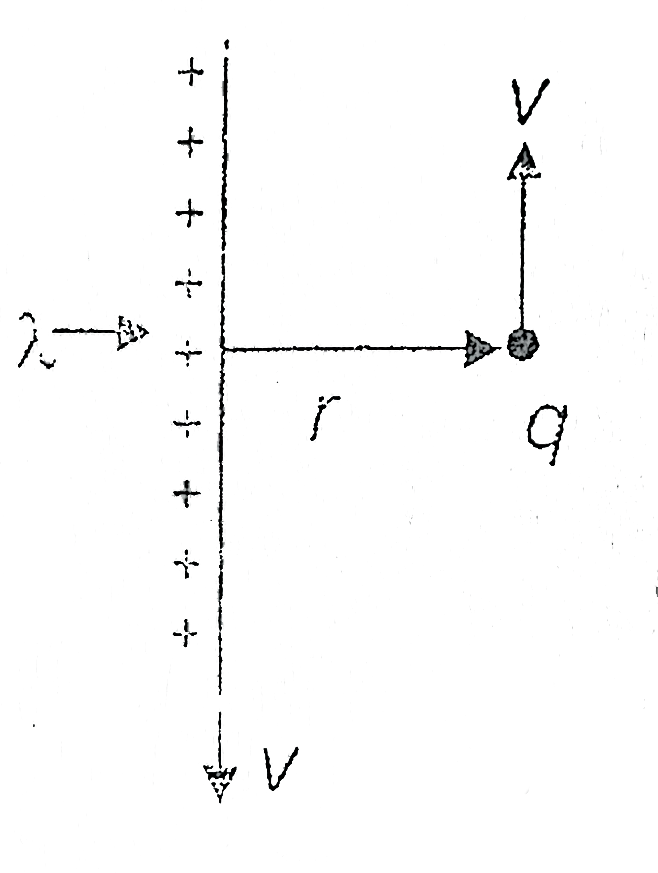A long wire having linear charge density λ moving with constant velocity v along its length. A point charge moving with same speed in opposite direction and at that instant it is at a distance r from the wire. The net force acting on the charge is given by

λq2πr[1ε0+v2μ0]
λq2πr[1ε0−μ0v2]
λq2πr√(1ε0)2+v4μ20
zero
Gauss Law for →E inside sphere
ε[E(4πr2)]=r∫0(kr)(4πr2)dr
E=kr22ε0
Electrostatic energy within =R∫012ε0E24πr2dr=(2πε0)R∫0k2r616ε20∝(R7)
Total charge within =R∫04πkr3dr=πkR4
Electric field at r>R=14πε0(πkR4r2)
Electric energy for ∞>r≥R=∞∫R(14πε0πkR4r2)24πr2dr2ε0=(const)R8∞∫R1r2dr=(const)R8[1R]=const(R7)
Electrostatic energy inside and outside sphere is ∝R7. So total ∝(R7)
Topper's Solved these Questions
Similar Questions
A long straight wire carries a charge with linear density λ. A particle of mass m and a charge q is released at a distance r from the the wire. The speed of the particle as it crosses a point distance 2r is
View SolutionIntensity of electric field at a point at a perpendicular distance .r. from an infinite line charge, having linear charge density .λ. is given by :
View Solution
Knowledge Check
For a long wire of charge density γ,, field at a distance r from the wire is
Aγ2πε0rnBγ4πε0rnC0DkqεeThe electric field at a distance r from a long wire having charge per unit length λ is
Ak(λr2)Bk(λr)Ck(λ2r)Dk(2λr)A long straight wire carries a charge with linear density λ. A particle of mass m and a charge q is released at a distance r from the the wire. The speed of the particle as it crosses a point distance 2r is
A√qλlnrπm∈0B√qλln2πm∈0C√qλln22πm∈0D√qλln2πm∈0
A point charge is moving along a straight line with a constant velocity v. Consider a small area A perpendicular to the direction of motion of the charge . Calculate the displacement current through the area when its distance from the charge is x. The value of x is not large so that the electric field at any instant is essentially given by Coulomb's law.

View SolutionA point charge is moving along a straight line with a constant velocity v. Consider a small area A perpendicular to the direction of motion of the charge . Calculate the displacement current through the area when its distance from the charge is x. The value of x is not large so that the electric field at any instant is essentially given by Coulomb's law.

View SolutionTwo parallel wires in the plane of the paper are distance X0 apart. A point charge is moving with speed u between the wires in the same plane at a distance X1 from one of the wires. When the wires carry current of magnitude I in the same direction , the radius of curvature of the path of the point charge is R1. In contrast, if the currents I in the two wires have directions opposite to each other, the radius of curvature of the path is R2. if X0X1=3, the value of R1R2 is
View SolutionTwo parallel wires in the plane of the paper are distance X0 apart. A point charge is moving with speed u between the wires in the same plane at a distance X1 from one of the wires. When the wires carry current of magnitude I in the same direction , the radfius of curvature of the path of the point charge is R1. In contrast, if the currentsd I in the two wires have directions opposite to each other, the radius of curvature of the path is R2. if X0X1=3, the value of R1R2 is
View SolutionTwo parallel wires in the plane of the paper are distance X0 apart. A point charge is moving with speed u between the wires in the same plane at a distance X1 from one of the wires. When the wires carry current of magnitude I in the same direction, the radius of curvature of the path of the point charge is R1 In contrast, if the currents I in the two wires have directions opposite to each other, the radius of curvature of the path is R2. If X0X1=3, the value of R1R2 is
View Solution
